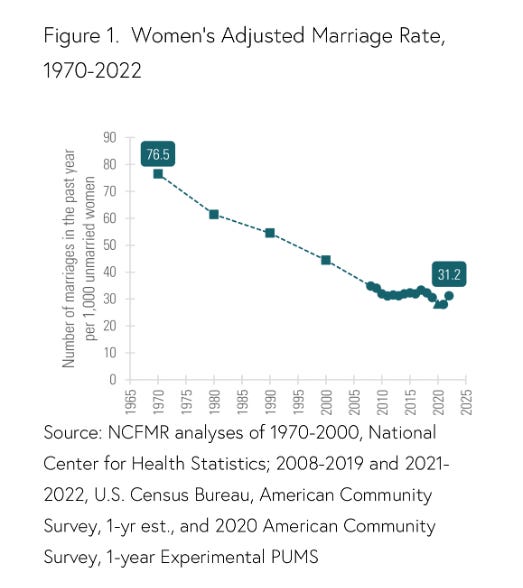The State of Marriage
Part 1: The Problem
Pope John XXIII said, "The family is the first essential cell of human society." Freedom-minded individuals, like me, rightly point to the recognition of natural law and the protection of God-given liberty as key to human flourishing. However, we often forget to be an apologist and advocate for the nuclear family itself. After all, without parents and their children, there would be no society to preserve.
To this end, the biblical standard of family reveals the importance of this unit in our world. In fact, given the origin story of humanity, the very first human relationship we witness in Scripture is a marriage. While God could have chosen to grow the human race in any number of ways, he formed us from the dust into flesh, and then made the flesh of a man and a woman become one. He chose to create society through the miracle of marriage.
Sadly, by practically every objective measurement, marriage is declining in America today. In future writings, I will discuss in more detail the cultural impacts, policy causes, and even practical suggestions regarding marriage. However, in this piece I will focus solely on the current state of marriage in America, as supported by objective evidence.
First, fewer Americans are getting married.
Peer-reviewed research shows that first-time marriage rates have fallen 60 percent over the past five decades. First time marriages have declined from 76.5 marriages per 1,000 unmarried women (ages 15 and older) in 1970 to just 31.3 per 1,000 unmarried women in 2018. Furthermore, researchers at Bowling Green State University illustrate the declining overall marriage rate in America over the last 60 years, illustrated in the graph below.

While the marriage rate may fluctuate in short cycles, it is evident from the greater body of research that fewer Americans are choosing to marry today. As researchers at the Brookings Institute simply describe the current state of marriage in our country, fewer Americans are married today than at any time in the last half-century.
Second, Americans are putting off marriage until later in their life.
While some blame economic considerations for delayed marriage rates, research has contradicted this widely-believed narrative. Regardless, Americans are simply getting married later in life. The data shows that the median age of a first marriage in the 1950s was 20 for women and 22 for men. In 2020, the median age rose to 28.1 for women and 30.5 for men.
Plus, most marriages today happen after cohabitation. Researchers have found that as many as 70 percent of marriages now happen after a couple lives together. While studies show at least a majority of Americans believe living together prior to marriage will increase their chance of marital success, University of Denver research indicates that pre-marriage cohabitation often increases the statistical likelihood of future divorce. In fact, according to the Institute for Family Studies, religious people in their 20s, who marry without pre-marriage cohabitation, have the lowest divorce rates.
Third, declining marriage rates could be impacting our birth-rate crisis.
Despite the prevalence of "hookup” culture, most research has found that younger Americans are having less sex than previous generations. According to Psychology Today, the generations that have had the least sex are millennials and Gen Zer’s. In fact, studies show that the number of American adults between the ages of 20 and 24 who reported no sexual partners since adulthood more than doubled between those born in the 1960s and those born in the 1990s.
The prevalence of pornography in today’s culture likely contributes to these numbers. According to researchers at Brigham Young University, pornography is viewed by about 70 percent of American men and 40 percent of American women in any given year. Their research also finds that using pornography correlates with decreased sex-life satisfaction and an increased chance of divorce. While pornography has likely existed in varying forms in practically every culture in human history, its availability and addictive nature has never been unleashed like it has through the internet and smart phones.
From a very practical perspective, our lack of sex could be helping to contribute to the death of Western Civilization. As discussed in previous posts, the declining birth rates in America and other developed nations threaten the continuation of our population and culture. Without even factoring in the existence and tragedy of abortion, it is simply logical to conclude that a society having less sex will likely have less babies.
In addition, the trend of marriage later in life certainly doesn’t help the statistical chances for couples to have children, given our biological clock. For example, a study by the University of St. Andrews and Edinburgh University in Scotland found women lost 90 percent of their eggs by the time they are 30 years old and have just 3 percent remaining by age 40.
While poor health, video games, cultural influences, and numerous other factors certainly play a role in the declining frequency of sex in our younger generations, one factor that few in the mainstream media want to discuss is the declining role of marriage within our culture.
Research has long found that married people generally have sex more frequently than nonmarried people. Even the liberal HuffPost ran an article admitting the reality that our hookup culture fails to comprehend: “Want More And Better Sex? Get Married And Stay Married.”
Whether you believe marriage is a sacred institution like I do, or you’re just worried about population replacement, all evidence points to a simple fact: marriage is essential for a thriving society.
Lastly, the heartland is not immune from the marriage problem.
According to a U.S. News & World Report analysis, most of the states with the highest divorce rates come from the heartland. In fact, eight out of the top ten are red states. The states with the highest divorce rates in the latest numbers (2022), as measured by US News as the number of women divorced within the last year per 1,000 women, include:
1. Arkansas (11.85)
2. Wyoming (11.01)
3. Kentucky (9.92)
4. West Virginia (9.66)
5. Oklahoma (9.34)
6. Idaho (9.24)
7. Alabama (9.09)
8. Delaware (9.08)
9. Tennessee (9.06)
10. New Mexico (9.05)
You might predict that this high divorce rate is connected to conservatives’ higher likelihood of marriage – that higher numbers of couples getting married simply translates statistically into more divorces. Most research does support the logical assumption that conservatives are more likely to be married than liberals. According to Institute for Family Studies, conservative Americans are more likely to be married and give greater moral significance to marriage than their liberal counterparts.
However, when you look at the marriage rates over the same period as the previous U.S. News analysis, only two states with the highest rates of divorce show up on the top ten list of highest marriage rates. Here are the states with the highest marriage rates, as measured by U.S. News as the number of women married with the last year per 1,000 women:
1. Colorado (20.9)
2. Nebraska (20.8)
3. South Carolina (20.6)
4. Wyoming (19.8)
5. Nevada (19.7) (tie)
5. Utah (19.7) (tie)
7. Washington (19.3)
8. Texas (19.1)
9. Missouri (19)
10. Arkansas (18.9)
While there could be many factors impacting these numbers, this analysis makes it clear that marriage issues in America are one of the few areas that do not seem to be directly impacted by whether we live in a blue or red state. Failed marriages just don’t seem to stop once you leave the liberal east and west coasts – in fact, our numbers are some of the worst here in the heartland.
Bottom Line
Our culture tells us that the most important thing for success in marriage, or any relationship for that matter, is compatibility. In reality, the most essential ingredient to a lasting relationship is commitment.
I agree that compatibility in marriage is essential. Physical attraction is important as well. But no matter how good you mesh or how big your spark, without commitment, everything else is meaningless.
Our digital age is built on the idea of choices. It has undoubtedly caused many to believe that if we can order a mate like we do on Amazon, where we can get any item to the exact specifications that we desire, then we can have a happy marriage. In fact, most dating sites base their entire system on providing matches through an algorithm based on your specified preferences. Yet, no matter how well you are matched, we cannot make love last if we do not commit for the long haul.
Genesis 2:24 says that “a man shall leave his father and his mother and hold fast to his wife, and they shall become one flesh.” The first instruction God gives us in pursuing marriage is to “leave.” Commitment requires the abandonment of all other options. That idea, in itself, is a strange concept in our times.




Good article that points to a lot of statistics that don't often get mentioned. Aaron Renn has some helpful insights into this topic as well.
https://www.aaronrenn.com/p/newsletter-73-ten-theses-on-marriage